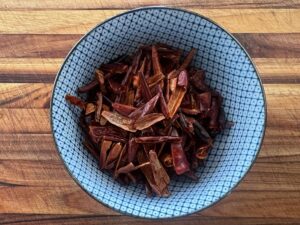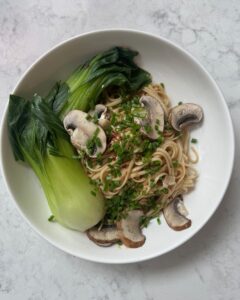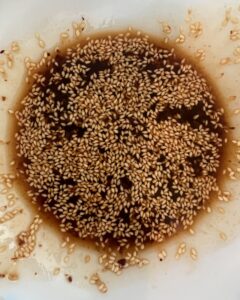It’s no secret: I’m promiscuous. About condiments, that is. I’ve almost never met a condiment I didn’t like. In my experience, having some good ones on hand means almost anything you have in the larder — a box of spaghetti, even — can become an interesting meal.
I recently expanded my condiment horizons on a spring trip to Australia. Intermingled with the savory pie vendors, cheese stands, and oyster bars at Melbourne’s sprawling Queen Victoria market were an amazing array of vendors selling the foods most appreciated by the growing Chinese community in the city: there were gorgeous vegetables like gai lan (Chinese broccoli) and ong choy (water spinach), as well as odd-looking ones like lotus root and warty bitter melon.

There were also enticing jars of soy and fish sauces, fermented shrimp paste, black and yellow bean pastes, and black rice vinegar. But since we still had a long trip ahead of us, I didn’t buy a single one. I was amazed at my own fortitude. And I spent a lot of time during the rest of the trip plotting how to bring some of the flavors of Melbourne home to Truro.
Help with that plan came one evening when we joined one of Christopher’s Australian colleagues, Trish, and her family at their home for dinner. Trish is Anglo-Australian; her husband, Franco, is an Italian immigrant; and their children, Catherine and James, are Asian. They gave us an inside look at some of the ways Australian society is changing, at least from one family’s point of view.
Despite some reactionary voices in their country, they all had observations about how Australians are becoming more comfortably conversant about the country’s complex history, the destructive dimensions of colonialism, and the evolving ethnic and cultural diversity of an increasingly — and self-consciously — Asian country.

Of course, not all we talked about was so weighty. Had we tried the local oysters? Had we been to Monarch Cakes? There were scores of foods our hosts believed we simply could not leave Melbourne without tasting.
Early in the evening I noticed several jars on the kitchen counter and couldn’t resist a query. It was chili oil, Catherine said — she had made it herself. She unscrewed the lid of a jar and I sniffed: the oil was fragrant, and with a quick dip of a spoon, I tasted a not-quite-identifiable spice along with the tingly tongue-numbing sensation characteristic of Sichuan peppercorns. It was not too hot, either.
Catherine told me that the oil was not only easy to make but was far superior to commercial varieties. She said that her family used it on just about everything needing a little kick of warmth. I resolved to try my hand once I was back in my kitchen in Truro.
A little research confirmed that chili oil is one of those must-have ingredients in a variety of Asian cuisines. It’s a staple for Chinese families, as important as ketchup is for many Americans.

Unsurprisingly, there are many recipes for chili oil featuring different kinds of chili flakes. Most often, though, they are from Sichuan (I turned to the Mala Market, an online purveyor of high-quality Chinese ingredients for mine). The main thing, I learned, is that it’s important to choose flakes with the seeds removed. The seeds produce an oil in which the heat masks the other subtle flavors you’re seeking. The standard Italian-style “peperoncino” is not suitable.
Because I happened to have a large bag of mild Tianjin peppers in the cupboard at home, I decided to make my own chili flakes. First, I toasted the whole peppers in a dry skillet until they became fragrant and began to darken. (Note to self after recovering from a coughing jag: don’t inhale deeply over a skillet full of hot peppers.) I let the peppers cool, then snipped them in half, removed the seeds, and ground them coarsely in a small food processor.
Although some cooks make a simple recipe with nothing but the chili itself, a range of aromatics can be used to flavor the oil. I chose cinnamon, bay leaves, star anise, cardamom, cloves, and Sichuan peppercorns — spices I had on hand and that I thought might produce the hard-to-pinpoint flavor of Catherine’s condiment.

Some chili oils are clear, strained not only of the aromatics but also of the chili solids. I left the chilis in mine in because I like the way the crisp umami bits coat whatever ingredients they’re added to, adding texture as well as flavor.
Since mixing up my batch, I’ve tried it in all kinds of dishes. I love it on fried eggs served over steamed rice seasoned with a little soy butter. Fried eggs and hot sauce are a classic combination in my native South, so I find this dish both familiar and new. I’ve used it on fried rice, added a jolt to a marinara sauce, and sprinkled it on Montano’s pizza.
It’s also excellent tossed with noodles and greens. If you’ve never tried udon, the squeaky-chewy texture of this Japanese-style noodle is worth searching out. But spaghetti works fine. And if there’s no bok choy, other greens from mustard to chard would be good. Toast the sesame seeds lightly in a small skillet to boost their flavor; they add an interesting texture as they, along with the bits of chilis, cling deliciously to the noodles.
MELBOURNE CHILI OIL
Makes about 2 cups
2 cups canola or other neutral oil
5 star anise pods
1 3-inch cinnamon stick
2 bay leaves
3 Tbsp. Sichuan peppercorns, picked over to remove black seeds
2 cardamom pods
2 tsp. whole cloves
1 cup seed-free chili flakes, preferably Sichuan
1 or 2 tsp. salt (to taste)
- Combine oil with the anise, cinnamon, bay leaves, Sichuan peppercorns, cardamom, and cloves in a medium saucepan (choose one with a heavy bottom). Allow the aromatic spices to infuse at a temperature of about 220-225° F for up to an hour. To achieve this, warm over medium heat, monitoring the temperature with an instant-read thermometer. As the oil heats, progressively lower the heat to medium low to stabilize the temperature. At about 225 degrees F, small bubbles will rise slowly through the oil — that’s OK.
- Place the chili flakes in a heatproof bowl. Once the oil is infused, pour it through a fine mesh strainer directly onto the chili flakes. Discard the spices that were used in the oil. As the oil and chili flakes combine, they smell a little like popcorn. Stir in the salt and allow the chili oil to cool. Store in airtight containers in the refrigerator.
CHILI NOODLES WITH BOK CHOY
Makes 2 servings
5 oz. udon or other noodles
8 oz. small bok choy or other greens such as chard or mustard, trimmed and sliced lengthwise
4 oz. mushrooms, wiped clean and sliced thick
1 Tbsp. toasted sesame oil
1 Tbsp. chili oil with solids
1 Tbsp. sesame seeds, lightly toasted
2 Tbsp. soy sauce, divided
1 garlic clove, minced
1 Tbsp. white miso paste
3 Tbsp. vegetable oil
Black pepper
2 or 3 scallions, thinly sliced
1 radish, thinly sliced
1 red or green chili pepper, seeded and thinly sliced
- Bring a large pot of water to a boil (if using udon, no salt is needed as they have already been seasoned), add the noodles, cook according to package directions, and drain.
- Meanwhile, steam the bok choy or other greens along with the sliced mushrooms until the greens are tender (for bok choy, about 5 to 7 minutes). Uncover and turn off the heat.
- While the greens steam, whisk together the sesame oil, chili oil (including some of the solids), toasted sesame seeds, one tablespoon of the soy sauce, the garlic, and miso paste in a large bowl.
- In a small saucepan over medium heat warm the vegetable oil until shimmering. Pour the hot oil over the sesame-chili oil mixture and whisk. Add the noodles and toss until each strand is well coated.
- Place the noodles, the bok choy and the mushrooms in shallow bowls. Sprinkle the greens with remaining soy sauce and a twist of black pepper, then shower the entire dish with sliced scallions, radishes, and fresh chilis.



